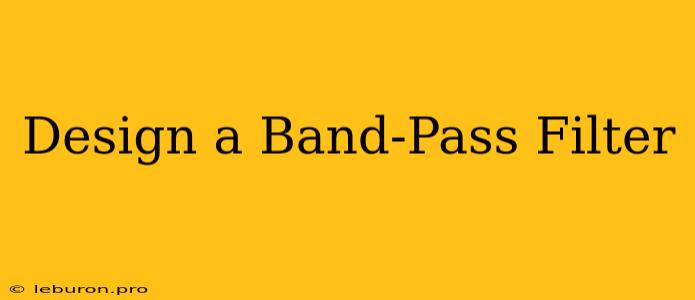Design a Band-Pass Filter: A Comprehensive Guide
Designing a band-pass filter is a fundamental task in many electronic circuits, allowing us to isolate and amplify a specific frequency range while attenuating others. This process involves carefully selecting components and understanding their relationships to achieve the desired filter characteristics. This article will provide a comprehensive guide on designing a band-pass filter, covering the theory behind its operation, different implementation methods, and practical design considerations.
Understanding Band-Pass Filter Fundamentals
A band-pass filter (BPF) is a type of electronic filter that passes frequencies within a specific range while attenuating frequencies outside that range. The desired range is defined by the filter's center frequency and its bandwidth. The center frequency (f<sub>c</sub>) represents the midpoint of the passband, while the bandwidth (BW) defines the width of the passband, typically measured in Hertz (Hz).
Figure 1: Band-Pass Filter Frequency Response
!
Key Properties of a Band-Pass Filter:
- Passband: The range of frequencies that the filter allows to pass through with minimal attenuation.
- Stopband: The range of frequencies that the filter significantly attenuates.
- Center Frequency (f<sub>c</sub>): The frequency at which the filter exhibits maximum gain.
- Bandwidth (BW): The range of frequencies around the center frequency that the filter passes.
- Quality Factor (Q): A measure of the filter's selectivity, indicating how sharply the filter transitions between passband and stopband. A higher Q value implies a narrower bandwidth and a more selective filter.
Design Methods for Band-Pass Filters
There are various methods to design a band-pass filter, each with its strengths and weaknesses. Here are some of the most common approaches:
1. Passive RC Filter
Figure 2: Passive RC Band-Pass Filter Circuit
!
This method uses a combination of resistors (R) and capacitors (C) to create the desired band-pass characteristic. The simplest implementation uses two RC stages, with a low-pass stage followed by a high-pass stage. The low-pass stage attenuates high frequencies, while the high-pass stage attenuates low frequencies, allowing only a specific range of frequencies to pass through.
Advantages:
- Simple design and implementation
- Uses readily available components
Disadvantages:
- Limited control over filter characteristics
- Can suffer from losses at high frequencies
2. Active Filter Design
Figure 3: Active Band-Pass Filter Circuit using Operational Amplifier (Op-Amp)
!
Active filters use active components, such as operational amplifiers (op-amps), to provide gain and improve filter performance. The use of op-amps allows for more precise control over the filter's characteristics and higher Q values.
Advantages:
- Greater flexibility in designing filter characteristics
- Higher Q values achievable
- Potential for gain in the passband
Disadvantages:
- Requires additional components, including op-amps
- Can be more complex to design
3. Crystal Filter
Figure 4: Crystal Band-Pass Filter Circuit
!
Crystal filters utilize piezoelectric crystals to create highly selective band-pass filters. These filters are known for their excellent stability, high Q values, and low insertion losses.
Advantages:
- Extremely high selectivity
- Excellent frequency stability
- Low losses
Disadvantages:
- Limited frequency range
- More expensive than other filter types
4. Digital Filter Design
Digital filters are implemented in software and utilize digital signal processing (DSP) techniques to achieve the desired filtering characteristics. They offer a wide range of possibilities for filter design and can be easily modified or adapted to different requirements.
Advantages:
- Highly flexible and customizable
- Can achieve complex filtering characteristics
- No physical components needed
Disadvantages:
- Requires a digital signal processor (DSP) or microcontroller
- May have higher latency compared to analog filters
Design Considerations
When designing a band-pass filter, it's essential to consider several factors to achieve the desired performance:
- Frequency Response: The filter's frequency response defines its passband, stopband, and overall behavior.
- Q Factor: The Q factor determines the selectivity of the filter. A higher Q factor implies a narrower bandwidth and a more selective filter.
- Gain: The filter's gain defines the amplification within the passband.
- Component Selection: The choice of components (resistors, capacitors, inductors, crystals) significantly impacts the filter's performance.
- Practical Constraints: Factors such as power consumption, size, and cost may limit the design options.
Practical Applications
Band-pass filters have widespread applications in various fields, including:
- Audio Systems: They are used in equalizers, crossovers, and audio amplifiers to isolate specific frequency ranges for enhanced sound quality.
- Radio Communication: They are crucial in radio receivers to filter out unwanted signals and isolate the desired frequency band.
- Medical Equipment: Band-pass filters are used in electrocardiogram (ECG) machines and other medical devices to isolate specific frequency components for diagnostics.
- Control Systems: They are used to filter out noise and isolate desired frequencies in control systems.
- Image Processing: Band-pass filters can enhance images by removing noise and isolating specific frequency components.
Conclusion
Designing a band-pass filter involves understanding the fundamentals of filter theory, exploring different design methods, and carefully considering practical constraints. This article has provided a comprehensive overview of the key concepts, design techniques, and practical applications of band-pass filters. By applying these principles, engineers and technicians can design effective filters to meet specific requirements in various electronic systems.
